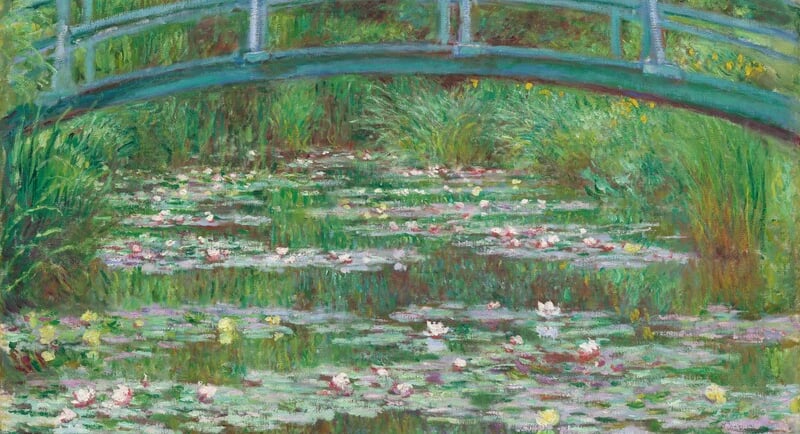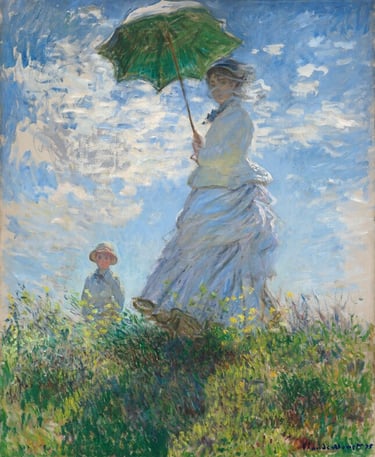Claude Monet and His Notable Contribution to Art History
6/4/20255 min read


Introduction to Claude Monet
Claude Monet, born on November 14, 1840, in Paris, France, is often celebrated as a pioneering figure in the realm of art history, particularly within the Impressionist movement. Growing up in a middle-class family, Monet developed an interest in art at an early age, influenced by his mother, who introduced him to painting. His early artistic endeavors included caricatures, which he sold to classmates, showcasing his innate talent. This early exposure laid the foundation for his later works, as Monet sought to capture the ephemeral beauty of nature.
Monet's journey as an artist was marked by significant influences and experiences. He studied at various art schools, including the Le Havre secondary school of the arts, where he honed his skills while embracing a variety of styles. The artistic climate of Paris during the late 19th century sparked his innovation, notably influenced by artists such as Édouard Manet and the Barbizon School, who emphasized the importance of light and atmosphere in their work. This interaction with contemporary artists led him to explore outdoor painting, which became a hallmark of his style.
As a prominent member of the Impressionist movement, Monet was instrumental in shifting the focus of art away from realism. His technique of using loose brush strokes allowed him to convey light and color in a manner that closely mimicked the perception of the natural world. His perspective on art was deeply shaped by his own life experiences, particularly his affinity for gardening and nature, as exemplified by his iconic garden in Giverny. Monet's unique vision ultimately established him as a leader in the movement, and his works not only captured the fleeting moments of life but also embodied a revolutionary approach that continues to inspire artists today.
Top Notable Works of Claude Monet
Claude Monet, an iconic figure in art history, is renowned for his pivotal role in the Impressionist movement. His masterful use of light and color revolutionized painting techniques and introduced new ways of seeing and interpreting nature. Below, we explore ten of his most significant works, showcasing his innovative style and lasting influence on subsequent generations of artists.
One of Monet's most celebrated paintings, Impression, Sunrise, created in 1872, played a key role in defining the Impressionist movement. The artwork depicts a hazy morning in the port of Le Havre, where the sun rises over misty waters. Monet's loose brushstrokes and emphasis on light capture the transient beauty of the moment, challenging traditional artistic conventions.
Another notable piece is Water Lilies, from his later years, which consists of a series of approximately 250 paintings. These works reflect his fascination with his flower garden in Giverny, showcasing a serene pond adorned with lilies. Through varied color palettes and brush techniques, Monet encapsulates the serenity and ephemerality of nature, evoking deep emotional responses in viewers.
The Japanese Bridge, painted around 1899, exemplifies Monet's integration of Japanese aesthetics and his obsession with capturing different light conditions. This work features a picturesque bridge flanked by vibrant foliage, demonstrating his skills in juxtaposing colors. The composition also reflects Monet’s innovative approach to depicting atmosphere and space, creating a sense of immersion for the viewer.
Other noteworthy mentions include Rouen Cathedral, a series highlighting the changing effects of light and atmosphere throughout the day, and Woman with a Parasol, celebrated for its dynamic composition and movement. Each of these works illustrates Monet's relentless pursuit of capturing the essence of nature, thus reinforcing his significant contribution to the evolution of modern art.
Monet's Techniques and Artistic Contributions
Claude Monet, a pivotal figure in the Impressionist movement, is renowned for his innovative techniques that contributed significantly to the evolution of art. His unique approach to light, color, and brushwork redefined the perception of natural scenes and laid the groundwork for future artistic movements. At the core of Monet's artistry was his revolutionary use of color, where he championed a departure from traditional color mixing, favoring the juxtaposition of complementary hues. This method not only intensified the vibrancy of his landscapes but also allowed the viewer's eye to blend the colors naturally, creating a dynamic visual experience.
Another hallmark of Monet's practice was his revolutionary commitment to plein air painting, the act of creating artworks in the open air rather than in a studio. This technique afforded him the ability to capture the transient effects of light and atmosphere directly as they occurred. By observing the changing conditions of the natural world, he was able to portray the ephemeral qualities of his subjects. His meticulous attention to light reflects how he understood that colors shift based on the time of day, season, and weather, further enhancing the realism present in his artworks.
Monet's brushwork was equally distinctive; his loose, rapid strokes conveyed movement and immediacy, fostering a sense of spontaneity in his pieces. This technique helped embody the fleeting moments of life, which were essential to the Impressionist ethos. His contributions to color theory also sparked new discussions among artists and scholars, inspiring future generations to explore and experiment with the representation of light and shadow. In establishing his effortless unique style, Monet not only defined his own works but also set the stage for modern art practices, establishing an enduring legacy that continues to influence artists even today.
Legacy and Influence in Art History
Claude Monet, a pivotal figure in the Impressionist movement, has left an indelible mark on the landscape of art history, influencing countless artists and movements that followed. His unique techniques, such as his innovative use of light and color, have become hallmarks of modern art. Monet’s style not only redefined how artists approached painting but also fostered a broader acceptance of diverse artistic expressions. His ability to capture fleeting moments through vibrant brushwork resonates today, challenging contemporary artists to break traditional boundaries.
Monet's influence extends beyond merely imitating his technique; it permeates the core philosophies of modern art. He emphasized the importance of subjective perception in painting, encouraging artists to reflect their emotions and experiences through their work. This tendency paved the way for various avant-garde movements, including Expressionism and Abstract Art, which have grown from the principles established by Monet and his contemporaries. His less rigid approach to composition and subject matter continues to inspire artists who prioritize experimentation and personal vision.
Modern exhibitions frequently celebrate Monet's contributions, underscoring the timeless relevance of his work. Collections in major galleries worldwide, such as the Musée d'Orsay and the National Gallery, maintain significant Monet pieces that attract large audiences, demonstrating his enduring appeal. Public appreciation of Monet's art speaks to its universal themes and emotional resonance, fostering a deeper connection between viewers and the natural world he so vividly portrayed.
Ultimately, Claude Monet's innovative vision plays a crucial role in understanding the evolution of artistic expression. His legacy encourages ongoing dialogue about art's purpose and relevance, affirming that art transcends time, continually inspiring new generations. In conclusion, Monet's contributions to art history not only exemplify his genius but also illuminate pathways for future explorations in the world of visual arts.




Explore a diverse collection of global art.
info@NiaInternationalArtworks.com
© 2025. All rights reserved.
Follow Us:
